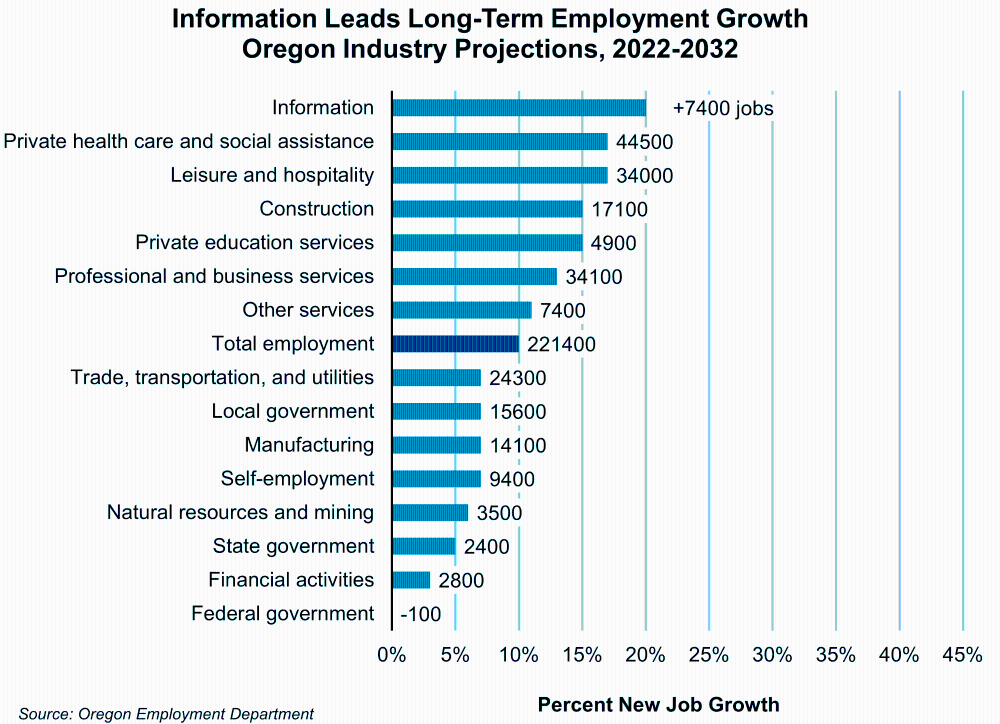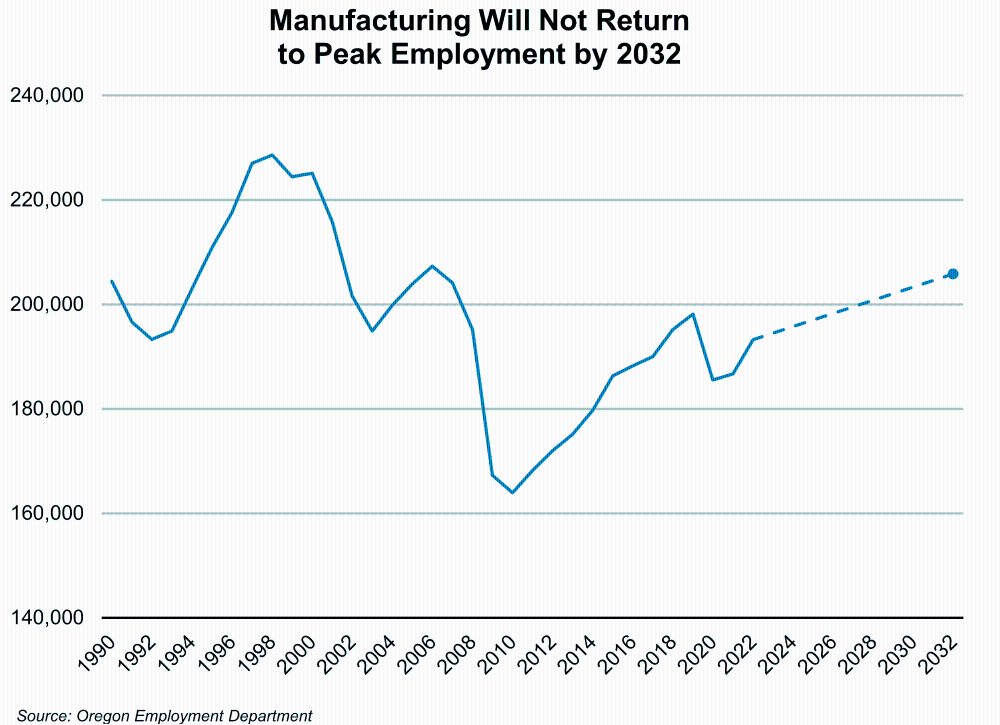Oregon Jobs Projected to Increase 10% by 2032
December 21, 2023Oregon’s total employment will grow by 221,000 jobs between 2022 and 2032, according to new projections from the Oregon Employment Department. Employment growth primarily reflects structural growth in the economy, as employment in many sectors had largely recovered from pandemic losses by 2022. Many additional job openings are expected due to the need to replace workers who leave their occupations.
In 2022, there were 2,131,600 jobs in Oregon. The projected 10% increase in employment between 2022 and 2032 includes private-sector gains of 194,100 jobs, growth of 17,900 jobs in government, and an additional 9,400 self-employed Oregonians.
Fastest-Growing Sectors
All broad sectors in Oregon are expected to add jobs by 2032 except for Federal government which is projected to remain relatively unchanged (-100 jobs). The information sector is projected to increase the fastest, growing 20% (+7,400 jobs). Information is a small sector comprised of establishments that produce and distribute information and cultural products, provide the means to transmit or distribute these products, and perform data processing. Growth in information can be attributed to expected growth in data processing and hosting services, software publishers, and the recovery of the motion picture and video industry from the Pandemic Recession.
The private health care and social assistance and leisure and hospitality sectors are projected to be the second fastest-growing sectors (17% growth each). Private health care and social assistance is also projected to add the largest number of jobs over the next 10 years. There may be little surprise seeing health care among the top sectors adding jobs, as it is one of the largest sectors in the state.
Private health care and social assistance is projected to add 44,500 jobs in the next 10 years. This growth is attributed to the aging of the state’s population, longer life expectancies, and an expected rebound in the state’s long-term population growth. Within health care and social assistance, nursing and residential care facilities (21%); ambulatory health care services (19%), such as doctor and dentist offices, chiropractors, physical and speech therapists, and other specialists; and social assistance (19%) that includes individual and family services and child day care services are expected to grow much faster than hospitals (7% growth). Rapid growth in nursing and residential care services is driven primarily by recovery from the Pandemic Recession.
Leisure and hospitality is projected to add the third-largest number of jobs (+34,000). Fast growth in the leisure and hospitality sector is mainly driven by the recovery from the Pandemic Recession, as more normal conditions resume for restaurants, hotels, and arts, cultural, and recreational establishments. Leisure and hospitality lost 51,700 jobs in 2020 relative to 2019. In 2022, leisure and hospitality was still 16,500 jobs short of its 2019 level, so nearly half of jobs added over the decade will be due to recovering lost jobs. By comparison, in the last set of projections prior to the pandemic, leisure and hospitality was ranked the fourth fastest-growing sector.

Construction (15% growth), private education services (15%), professional and business services (13%), and other services (11%) are all projected to grow faster than the economy as a whole from 2022 to 2032.
Peak Employment
While overall employment in many sectors is expected to grow beyond their peak levels, manufacturing will fall short of its peak employment by 2032. Manufacturing employment is expected to grow by 7% to 205,800 jobs. That's below its most recent peak of 207,300 jobs in 2006. Its all-time high was 228,600 jobs in 1998. In 2020, manufacturing lost 6% of its jobs (-12,700 jobs).

The manufacturing sector consists of industries growing in notably different ways. Some smaller components of manufacturing – such as transportation equipment manufacturing (12%), machinery manufacturing (14%), and primary metal manufacturing (19%) – show higher projected growth rates. In 2020, transportation equipment manufacturing lost 13% of its jobs (-1,700 jobs) and primary metal manufacturing lost 17% of its jobs (-1,600 jobs). Meanwhile, paper manufacturing (-14%), fruit and vegetable preserving (-3%), and sawmills and wood preservation (-3%) show projected declines by 2032. Paper manufacturing and sawmills and wood preservation experienced stable employment in 2020. Paper manufacturing includes pulp, paper, and paperboard mills and converted paper product manufacturing.
Declining Industries
Several industry groups with the biggest projected losses relate to news media, production and distribution of various paper-related products, and retail trade. These include computer and peripheral equipment manufacturing (-33%); newspaper, periodical, book, and directory publishers (-32%); business support services (-24%); pulp, paper, and paperboard mills (-24%); electronics and appliance stores (-23%); and radio and television broadcasting (-23%).
Government
Projections show relatively modest growth in most broad areas of government. State government is expected to grow by 5% and local government is expected to grow 7%. Employment in federal government is projected to remain flat over the decade with a loss of 100 jobs (-0.4%).
All Industries Need Workers
Whether growing rapidly or showing a net loss of jobs by 2032, all broad industries provide employment opportunities to Oregonians. The demand is clear in some industries. Slower growing sectors and declining industries still offer many job opportunities though, as there is a need to replace retiring workers or others leaving the industry.
More information on 2022-2032 industry and occupational projections for Oregon and sub-state areas can be found at QualityInfo.org/projections.